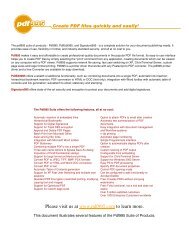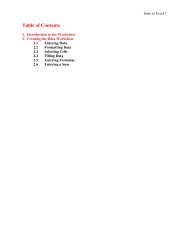fsdfsdfsd
sdfsdfsd
sdfsdfsd
You also want an ePaper? Increase the reach of your titles
YUMPU automatically turns print PDFs into web optimized ePapers that Google loves.
fact, I need to make an effort to remember it at all. So, while the World Wide Web<br />
provides a retrieval mechanism to complement the existing storage mechanism, it leaves<br />
a lot to be desired, particularly for human beings.<br />
Finally, we move to "perceptualized" Internetworks, where the data has been sensualized,<br />
that is, rendered sensually. If something is represented sensually, it is possible to make<br />
sense of it. VRML is an attempt (how successful, only time and effort will tell) to place<br />
humans at the center of the Internet, ordering its universe to our whims. In order to do<br />
that, the most important single element is a standard that defines the particularities of<br />
perception. Virtual Reality Modeling Language is that standard, designed to be a<br />
universal description language for multi-participant simulations.<br />
These three phases, storage, retrieval, and perceptualization are analogous to the human<br />
process of consciousness, as expressed in terms of semantics and cognitive science.<br />
Events occur and are recorded (memory); inferences are drawn from memory<br />
(associations), and from sets of related events, maps of the universe are created (cognitive<br />
perception). What is important to remember is that the map is not the territory, and we<br />
should avoid becoming trapped in any single representation or world-view. Although we<br />
need to design to avoid disorientation, we should always push the envelope in the kinds<br />
of experience we can bring into manifestation!<br />
This document is the living proof of the success of a process that was committed to being<br />
open and flexible, responsive to the needs of a growing Web community. Rather than reinvent<br />
the wheel, we have adapted an existing specification (Open Inventor) as the basis<br />
from which our own work can grow, saving years of design work and perhaps many<br />
mistakes. Now our real work can begin; that of rendering our noospheric space.<br />
History<br />
VRML was conceived in the spring of 1994 at the first annual World Wide Web<br />
Conference in Geneva, Switzerland. Tim Berners-Lee and Dave Raggett organized a<br />
Birds-of-a-Feather (BOF) session to discuss Virtual Reality interfaces to the World Wide<br />
Web. Several BOF attendees described projects already underway to build three<br />
dimensional graphical visualization tools which interoperate with the Web. Attendees<br />
agreed on the need for these tools to have a common language for specifying 3D scene<br />
description and WWW hyperlinks -- an analog of HTML for virtual reality. The term<br />
Virtual Reality Markup Language (VRML) was coined, and the group resolved to begin<br />
specification work after the conference. The word ’Markup’was later changed to<br />
’Modeling’to reflect the graphical nature of VRML.<br />
APPROVED









